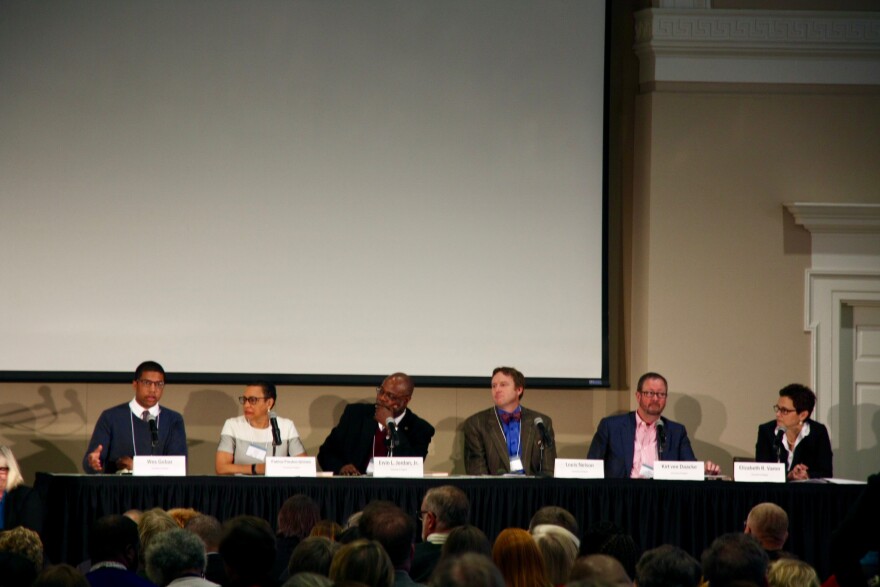The Slave Dwelling Project recently held its largest ever event at the University of Virginia to commemorate the hundreds of enslaved men, women and children who built and ran the school in the 19th century. Nearly 3-dozen panels saw more than 100 speakers over the three days. But at the center was an outdoor sleepover in near freezing temperatures, where the enslaved would have slept.
“I was…I was uncomfortable,” recalled April Burns. “I was very uncomfortable.”
April Burns’ ancestors were enslaved by three generations of Jeffersons.
They were enslaved, Burns remembers, but they were together. Then, in 1827, the horrific: they were split apart. Her four times great aunt, Fanny, came here—bought and enslaved by UVA anatomy professor Robley Dunglison—mere feet from where Burns laid her sleeping bag for the night. She stared into the darkness, imagining her ancestors’ reality. Their discomfort. And she felt it.
“So I interpret it as, they were uncomfortable, I was uncomfortable,” said Burns. “I was restless, I was cold, I was fidgety, and messing with my sleeping bag, and messing with the blanket over my head until I finally just got up at 3:30 at the morning and sat on the bench.”

Burns joined about 50 others that night, behind a student pavilion, where the university’s elite now live. It’s where white students and professors forced the African Americans they enslaved to chop their wood, do their laundry, cook their food. A serpentine brick wall surrounds the space. It was designed to muffle the sounds of the enslaved from the white outside world.
These and hundreds of other hidden or ignored examples of slavery’s lasting impacts were on full display last week as UVA’s President’s Commission on Slavery and the University hosted its first symposium. Assistant Dean and History Professor Kirt Von Daacke is the commission’s co-chair. In the 19th century, he said, more than half of Albemarle County’s population was enslaved. That’s as many as 14,000 African Americans.
“Three out of every four white adult males own at least one slave in the county,” said Von Daacke. “This is a center of significant slave holding.”
But until recently, UVA didn’t share its role with visitors, students, or professors, said President Teresa Sullivan who formed the commission in 2013.
“They found there had been efforts to literally hide, even to destroy some of what was known about slavery at the university,” said Sullivan of the commission’s work.
As the founder of the Slave Dwelling Project Joe McGill has slept at more than 100 sites where the formerly enslaved lived. Speaking to a crowd seated around candlelit tables, McGill recalled that two months ago, there was a different presence at UVA. One that made international headlines.

"There had been efforts to literally hide, even to destroy some of what was known about slavery at the university."
“That flame that we’re looking at was once upon a time in the form of a tiki torch, and we’re here to counter that folks,” said McGill.
The violence the white supremacist rallies of August 11th and 12th brought to Charlottesville harkened back to the violence visited on the enslaved. Many of the symposiums discussions centered around this: the enduring legacies of slavery. Connecting the past to the present. How, as much as things have changed, some things haven’t changed at all. Michael Swanberg is an assistant professor of nursing at UVA, and has seen racial disproportionality in the deaths of infants.
“When we dig deeper, it’s about three babies per thousand die in the white population, and 22 babies per thousand die in the African American population, so we have a 5 times higher infant mortality rate right here in Charlottesville,” said Swanberg.
This was far from the only example laid out over the week. During a panel discussion on reparations, a Duke University professor cited a recent Federal Reserve study that found the median net worth for white families in the U.S. is $171,000, compared to $17,000 for African Americans.

During another panel, archivist and associate professor at UVA Ervin Jordan detailed how he hears often about the historical discriminatory practices of the university, where only 6 percent of the student body is African American.
“I think one of the things that UVA needs to consider is legacy admissions for people who are descendants of slaves who worked here, that’s one thing,” said Jordan.
On the west side of UVA’s campus is a massive cemetery, where more than a thousand confederate soldiers are buried. Five years ago, archaeologists discovered a small plot on the north side, just outside the stone wall—67 unmarked graves of enslaved African Americans. For decades, it had been forgotten, along with accounts of grave robbing and cadaver sales. But last Thursday, in the dead of night, April Burns joined more than a hundred people, as they walked with candles in hand and visions of a more equitable future.
This report, provided by Virginia Public Radio, was made possible with support from the Virginia Education Association.




